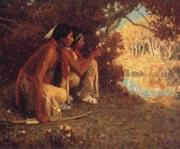 |
Eanger Irving Couse -- Click Here
|
|
American Painter , b.1866 d.1936
was an artist and founding member of the Taos artists colony in Taos, New Mexico. Couse was born in Saginaw, Michigan, where he first started drawing the Chippewa Indians who lived nearby. Couse attended the Art Institute of Chicago, and the National Academy of Design, New York. He left for Paris to study at the Ecole des Beaux-Arts and Academie Julian under Bouguereau. He lived in France 10 years, where he painted charming scenes of the Normandy coast. After his return to America he devoted himself to depicting the life and habits of the Taos Indians, a pueblo tribe in New Mexico. He reveals the poetical and philosophical rather than the savage and warlike side of the Indians, and his skillfully executed pictures are full of sentiment. |
|
|
|
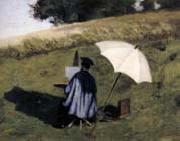 |
Dutilleux Constant -- Click Here
|
|
French , 1807-Arras 1865
|
|
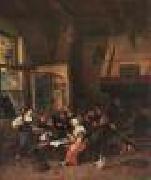 |
DUSART, Cornelis -- Click Here
|
|
Dutch Baroque Era Painter, 1660-1704
Dutch painter, draughtsman and printmaker. He was the son of the organist at St Bavo in Haarlem and one of the last pupils of Adriaen van Ostade. He became a member of the Haarlem Guild of St Luke on 10 January 1679 and served as its dean in 1692. Dated pictures by Dusart have survived from almost every year between 1679 and 1702. Two of his earliest pictures of peasants relied heavily on compositions by van Ostade: Mother and Child (1679; Dresden, Gemeldegal. Alte Meister) and Woman Selling Milk (1679; sold Amsterdam, Muller, 16 Oct 1928, lot 9; the original drawing by van Ostade is in Paris |
|
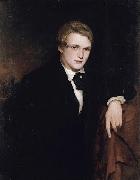 |
Douglas Cowper -- Click Here
|
|
painted William Powell Frith in 1836-1838
|
|
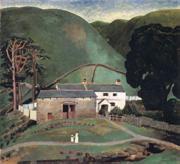 |
Dora Carrington -- Click Here
|
|
British Painter,
1893-1932
English painter and decorative artist. Daughter of a Liverpool merchant, she was brought up in Bedford. She trained at the Slade School of Fine Art in London where she met John Nash, who aroused her interest in wood-engraving, and Mark Gertler, whose powerful figure paintings influenced her own approach to portraiture. She rejected Gertler as a lover and set up home with the homosexual essayist and biographer Lytton Strachey (1880-1932), first at Tidmarsh Mill, near Pangbourne, Berks, then at Ham Spray, between Newbury and Hungerford, Berks. In 1921 she married Ralph Partridge, living with him and Strachey in a m?nage ? trois, surrounded mainly by literary friends and receiving little encouragement to exhibit. She turned instead to decorative work, emulating Vanessa Bell and Duncan Grant but in a style more native in inspiration and more naive. She designed tiles and inn signs, experimented with painting on glass and tinfoil, decorated furniture and designed the library at Ham Spray. |
|
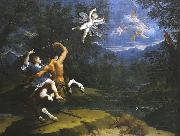 |
Donato Creti -- Click Here
|
|
(1671-1749) was an Italian painter of the Rococo period, active mostly in Bologna.
Born in Cremona, he moved to Bologna, where he was a pupil of Lorenzo Pasinelli. He is described by Wittkower as the "Bolognese Marco Benefial", in that his style was less decorative and edged into a more formal neoclassical style. It is an academicized grand style, that crystallizes into a manneristic neoclassicism, with crisp and frigid modeling of the figures. Among his followers were Aureliano Milani, Francesco Monti, and Ercole Graziani the Younger. Two other pupils were Domenico Maria Fratta and Giuseppe Peroni |
|
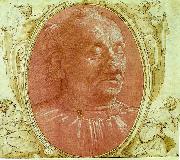 |
domenico chirlandaio -- Click Here
|
|
Domenico Ghirlandaio (1449 - 11 January 1494) was an Italian Renaissance painter from Florence. Among his many apprentices was Michelangelo.
Ghirlandaio's full name is given as Domenico di Tommaso di Currado di Doffo Bigordi. The occupation of his father Tommaso Bigordi and his uncle Antonio in 1451 was given as 'setaiuolo a minuto,' that is, dealers of silks and related objects in small quantities. He was the eldest of six children born to Tommaso Bigordi by his first wife Mona Antonia; of these, only Domenico and his brothers and collaborators Davide and Benedetto survived childhood. Tommaso had two more children by his second wife, also named Antonia, whom he married in 1464. Domenico's half-sister Alessandra (b. 1475) married the painter Bastiano Mainardi in 1494.
Domenico was at first apprenticed to a jeweller or a goldsmith, most likely his own father. The nickname Il Ghirlandaio (garland-maker) came to Domenico from his father, a goldsmith who was famed for creating the metallic garland-like necklaces worn by Florentine women. In his father's shop, Domenico is said to have made portraits of the passers-by, and he was eventually apprenticed to Alessio Baldovinetti to study painting and mosaic. |
|
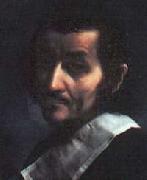 |
DOLCI, Carlo -- Click Here
|
|
Italian Baroque Era Painter, 1616-ca.1686
was an Italian painter of the Baroque period, active mainly in Florence, known for highly finished religious pictures, often repeated in many versions. He was born in Florence, on his mother's side the grandson of a painter. Although he was precocious and apprenticed at a young age to Jacopo Vignali, Dolci was not prolific. "He would take weeks over a single foot", according to his biographer Baldinucci.His painstaking technique made him unsuited for large-scale fresco painting. He painted chiefly sacred subjects, and his works are generally small in scale, although he made a few life-size pictures. He often repeated the same composition in several versions, and his daughter, Agnese Dolci, also made excellent copies of his works. Dolci was known for his piety. It is said that every year during Passion Week he painted a half-figure of the Saviour wearing the Crown of Thorns. In 1682, when he saw Giordano, |
|
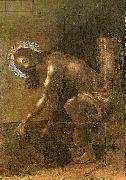 |
Diego de Carpio -- Click Here
|
|
painted Christ gathering his clothes after the Flagellation in 1798 |
|
|
|
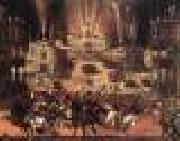 |
DERUET, Claude -- Click Here
|
|
French Baroque Era Painter, 1588-1660
was a famous French Baroque painter of the 17th century, from the city of Nancy. Deruet was an apprentice to Jacques Bellange, the official court painter to Charles III, Duke of Lorraine. He was in Rome between ca. 1612 and 1619, where - according to Andre Felibien - he studied with the painter and etcher Antonio Tempesta. During his stay in Rome, he painted the Japanese samurai Hasekura Tsunenaga on a visit to Europe in 1615. Deruet was made a noble by the Duke of Lorraine in 1621, and was then made a Knight of the Order of St Michel in 1645 by Louis XIII, who had in 1641 absorbed most of Lorraine into France. He had a luxurious residence in Nancy, named La Romaine, where Louis XIII and his Queen stayed in 1633. Claude Lorrain was an apprentice to Claude Deruet in 1623 for one year. |
|
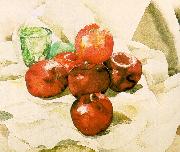 |
Demuth, Charles -- Click Here
|
|
American Precisionist Painter, 1883-1935
American painter and illustrator. He was deeply attached to Lancaster, where his family had run a tobacco shop since 1770. Although not a Regionalist, Demuth maintained a strongly localized sense of place, and Lancaster provided him with much of the characteristic subject-matter of both his early and later work. He trained in Philadelphia at the Drexel Institute of Art, Science and Industry (1901-5) and at the Pennsylvania Academy of the Fine Arts (1905-11), where his teachers included Thomas Anshutz, Henry McCarter (1864-1942), Hugh Breckenridge (1870-1937) and William Merritt Chase. |
|
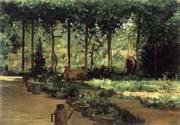 |
Demetrio Cosola -- Click Here
|
|
San Sebastiano,Po 1851-1895 Chivasso
|
|
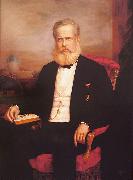 |
Delfim da Camara -- Click Here
|
|
painted Portrait of Dom Pedro II in 1875 |
|
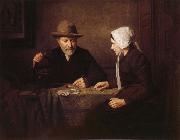 |
Delannoy jules Charles -- Click Here
|
|
Bethune
1852-1925
|
|
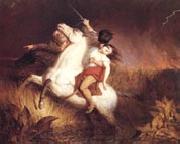 |
Deas Charles -- Click Here
|
|
American Painter
1818-1867
After an unsuccessful attempt to obtain an appointment at West Point Military Academy, he turned to an artistic career. He quickly earned recognition at the annual exhibitions of the National Academy of Design, New York, to which he was elected an associate member in 1839, with subjects taken from James Fenimore Cooper, |
|
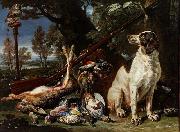 |
David de Coninck -- Click Here
|
|
(ca. 1644 Antwerp - after 1701, Brussels), also known as Rammelaar was a Flemish painter of the Baroque period. David Koninck was born in Antwerp and studied there under Jan Fyt. After a few years in Paris, he staid in Rome from ca 1671 to 1694, where joined the Bentvueghels with the nickname Rammelaar (rattle). He is sometimes stated to have died in Rome in 1687; however, he returned to his home country and is last recorded becoming a member of the painters guild in Brussels in 1701. His pictures are chiefly landscapes with animals and still life. He is likely unrelated to the generally contemporary Dutch painters, Philip de Koninck, or Philips Koninck (5 November 1619, Amsterdam - buried 4 October 1688, Amsterdam) and the fellow townsman Salomon de Koninck.
See Biography by Filippo Baldinucci.
|
|
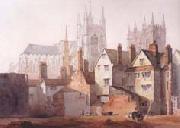 |
David Cox -- Click Here
|
|
David Cox [English Painter, 1783-1859]
English painter. After taking drawing lessons from Joseph Barber (1757/8-1811) in Birmingham, Cox worked briefly as an apprentice to a painter of lockets and snuff-boxes named Fieldler. This was followed about 1800 by a longer period painting scenery for the New Theatre, Birmingham. On the promise of similar employment at Astley's Amphitheatre in Lambeth, Cox travelled to London in 1804, but when this came to nothing he decided to make his name as a watercolour painter. He began exhibiting at the Royal Academy in 1805 and from 1809 until its demise in 1812 with the Associated Artists in Water-Colours, of which he became both member and president in 1810. He was elected an Associate of the Society of Painters in Water-Colours in 1812 and within a month had advanced to full membership. |
|
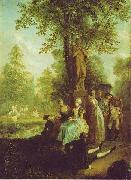 |
Daniel Chodowiecki -- Click Here
|
|
(16 October 1726 - 7 February 1801) was a Polish - German painter and printmaker with Huguenot ancestry, who is most famous as an etcher. He spent most of his life in Berlin, and became the director of the Berlin Academy of Art.
He was born in the city of Danzig in Poland, and in a letter in typical Berlin humor wrote, that he moved to Berlin, Germany, which shows for sure, that he is a 'genuine Pole'.[citation needed] He kept close to the Huguenot scene, due to his ancestry. A distant ancestor Bartholom us Chodowiecki had lived in the 16th century in Greater Poland . Gottfried Chodowiecki, Daniel's father, was a tradesmen in Danzig and his mother, Henriette Ayrer born in Switzerland, was a Huguenot. Daniel's grandfather Christian had been a tradesmen in the city as well. When his father died, both Daniel (aged 16) and his younger brother Gottfried Chodowiecki went to live with their uncle in Berlin, who offered to educate them, and where Daniel received an artistic training with the painter Haid in Augsburg. His brother also became a painter.
Soon Daniel was able to earn a living by painting. He was admitted to the Berlin Academy in 1764 and became vice-director under Rhode in 1788. He had found his true calling and became the most famous German graphic artist of his time. His works include several thousand etchings, usually rather small, and many drawings and paintings. He illustrated nearly all of the great classics. His prints represent in great detail the life of the middle classes during the Zopfstil period, a time between Rococo and Classicism. In 1797 Chodowiecki was appointed director of the Academy of Arts in Berlin, where he died on 7 February 1801. The bulk of his work was in illustrating scientific books by Basedow, Buffon, Lavater, Pestalozzi and others. He also painted many portraits of Polish gentry and was interested in Huguenot and Polish history as well, making some paintings on the topic. He was in tune with the developing spirit of the age, and many works reflect the cult of sensibility, and then the revolutionary and German nationalist feelings of the end of the century. |
|
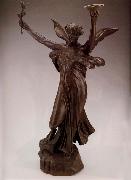 |
Daniel Chester French -- Click Here
|
|
American Neoclassical Sculptor, 1850-1931.was an American sculptor. His best-known work is the sculpture of a seated Abraham Lincoln at the Lincoln Memorial in Washington, D.C. French was born in Exeter, New Hampshire, to Henry Flagg French, a lawyer, Assistant US Treasury Secretary and author of a book that described the French drain. Daniel Chester French was a neighbor and friend of Ralph Waldo Emerson, and the Alcott family. His decision to pursue sculpting was influenced by Louisa May Alcott's sister May Alcott. After a year at the Massachusetts Institute of Technology, French worked on his father's farm. While visiting relatives in Brooklyn, New York City, he spent a month in the studio of John Quincy Adams Ward, then began to work on commissions, and at the age of twenty-three received from the town of Concord, Massachusetts, an order for his well-known statue The Minute Man, which was unveiled April 19, 1875 on the centenary of the Battle of Lexington and Concord. Previously French had gone to Florence, Italy, where he spent a year working with sculptor Thomas Ball. In 1917, he designed the Pulitzer Prize gold medal presented to laureates. In collaboration with Edward Clark Potter he modelled the George Washington statue, presented to France by the Daughters of the American Revolution; the General Grant in Fairmount Park, Philadelphia, and the General Joseph Hooker statue in Boston. In 1893, French was a founding member of the National Sculpture Society, and he became a member of the American Academy of Arts and Sciences. French also became a member of the National Academy of Design (1901), the American Academy of Arts and Letters, the National Sculpture Society, the Architectural League, and the Accademia di San Luca, of Rome. French was one of many sculptors who frequently employed Audrey Munson as a model. |
|
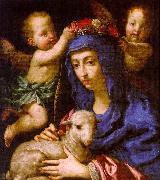 |
Dandini, Cesare -- Click Here
|
|
Italian Baroque Era Painter, 1595-1658 |
|
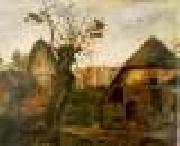 |
DALEM, Cornelis van -- Click Here
|
|
Flemish painter (active 1535-1576) |
|
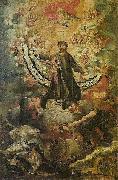 |
Cuzco School -- Click Here
|
|
The Cuzco School (Escuela Cuzqueña) was a Roman Catholic artistic tradition based in Cusco, Peru (the former capital of the Inca Empire) during the Colonial period, in the 16th, 17th and 18th centuries. It was not limited to Cuzco only, but spread to other cities in the Andes, as well as to present day Bolivia and Ecuador.
|
|
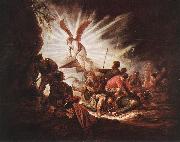 |
CUYP, Benjamin Gerritsz. -- Click Here
|
|
b. 1612, Dordrecht, d. 1652, Dordrecht
Dordrecht,,Painter, half-brother of Jacob Cuyp. Houbraken stated that he studied with his half-brother Jacob. Benjamin entered the Guild of St Luke on 27 January 1631, at the same time as his brother Gerrit Gerritsz. the younger. In 1641 Benjamin gave evidence in a medical affair, which has prompted speculation that he may have trained as a doctor, but in 1643 he is twice recorded in The Hague as a painter, living with other artists. |
|
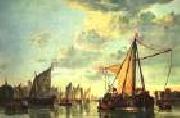 |
CUYP, Aelbert -- Click Here
|
|
Dutch Baroque Era Painter, 1620-1691
Painter and draughtsman, son of (1) Jacob Cuyp. One of the most important landscape painters of 17th-century Netherlands, he combined a wide range of sources and influences, most notably in the application of lighting effects derived from Italianate painting to typical Dutch subjects. Such traditional themes as townscapes, winter scenes, cattle pieces and equestrian portraits were stylistically transformed and given new grandeur. Aelbert was virtually unknown outside his native town, and his influence in the 17th century was negligible. |
|
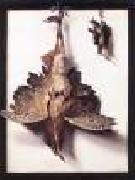 |
CUYCK VAN MYEROP, Frans -- Click Here
|
|
Flemish painter (b. ca. 1640, Brugge, d. 1689, Gent) |
|
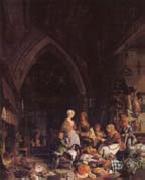 |
Cuvelier Hippolythe -- Click Here
|
|
Saint-Omer 1803-1876
|
|
|
|
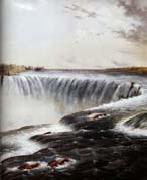 |
Currier and Ives -- Click Here
|
|
American Publisher, 1834-1907 |
|
 |
CRIVELLI, Vittorio -- Click Here
|
|
Italian painter, Venetian school (b. ca. 1440, Venezia, d. 1501/2, Venezia) |
|
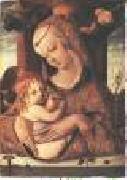 |
CRIVELLI, Carlo -- Click Here
|
|
Italian Early Renaissance Painter, ca.1430-1495
He produced many large, multi-partite altarpieces in which his highly charged, emotional use of line, delight in detail, decoration and citric colours, often set against a gold ground, convey an intensity of expression unequalled elsewhere in Italy. His mastery of perspective was also used for dramatic impact. As he worked in isolation in the Marches, his style only had local influence. In the 19th century, |
|
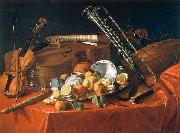 |
Cristoforo Munari -- Click Here
|
|
(July 21, 1667 - June 3, 1720) was an Italian painter of the late-Baroque specializing in still life paintings. He was also known as Cristofano Monari.
His initial training was in Reggio Emilia, his birthplace, and he came under the patronage of Rinaldo d'Este, Duke of Modena. In 1703-1706, he lived in Rome, then moved to Florence, where for about a decade he was attached to the court of the Medici. His still life paintings recall those of Evaristo Baschenis; however, the added disarray of porcelain, glass, and foodstuffs, suggest the hangover from the jovial surfeit of the Medici court. He painted also panoplies and war trophies. In 1715 he moved to Pisa where he worked almost exclusively in art restoration; he died in 1720.
An exhibition of his paintings took place in 1998 in Reggio Emilia, where it attracted wide attention and was a national success.
|
|
 |
Cristofano Gherardi -- Click Here
|
|
(November 25, 1508 - April 1556) was an Italian painter of the late-Renaissance or Mannerist period, active mainly in Florence and Tuscany.
He was born in Borgo San Sepolcro and also called il Doceno dal Borgo. He was the pupil of the painter Raffaellino del Colle, in whose shop he encountered Rosso Fiorentino and Giorgio Vasari. He painted under Vasari's direction, the one assistant of Vasari's whom Sidney J. Freedberg singles out.
In 1536 Vasari invited him to Florence to assist in producing the decorations for the ceremonial entry of Charles V into Florence. The following year, in the reaction after Duke Alessandro's death, Gherardi was among those banished from Florence, so his work for Vasari was confined to projects outside Florence, until his banishment was lifted in 1554 and he was permitted to return . In the long interval he had painted the Visitation of Mary to Elizabeth for the church of San Domenico in Citte di Castello, church decorations in San Sepolcro, and works for the Vitelli, who were long-term patrons. Gherardi, in the two years left to him, assisted Vasari in the Quartiere degli Elementi in Palazzo Vecchio. Vasari's main assistant after Gherardi's demise was Jan van der Straat, called Giovanni Stradano.
|
|
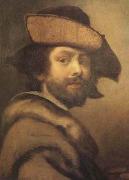 |
Cristofano Allori -- Click Here
|
|
Italian Baroque Era Painter, 1577-1621
was an Italian portrait painter of the late Florentine Mannerist school. Allori was born at Florence and received his first lessons in painting from his father, Alessandro Allori, but becoming dissatisfied with the hard anatomical drawing and cold coloring of the latter, he entered the studio of Gregorio Pagani (1558-1605) who was one of the leaders of the late Florentine school, which sought to unite the rich coloring of the Venetians with the Florentine attention to drawing. Allori also appears to have worked under Cigoli. His pictures are distinguished by their close adherence to nature and the delicacy and technical perfection of their execution. His technical skill is shown by the fact that several copies he made of Correggio's works were thought to be duplicates by Correggio himself. His extreme fastidiousness limited the number of his works. Several specimens are to be seen at Florence and elsewhere. The finest of his works is his Judith with the Head of Holofernes. It exists in two copies in the Pitti Palace in Florence and in the Queen's Gallery in London. |
|
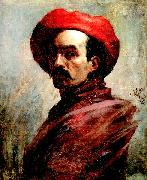 |
Cristobal Rojas -- Click Here
|
|
Cristobal Rojas (Cua, Miranda, 15 December 1857 e Caracas, 8 November 1890) was one of the most important and high-profile Venezuelan painters of the 19th century. Rojas's styles varied considerably throughout his life, and he displayed talents in painting that ranged primarily for dramatic effect, to works done in the Impressionist style.
Cristebal Rojas Poleo was born in the city of Cea in the Valles del Tuy to parents who worked in the medical profession. Part of his childhood occurred during the middle of the federal war (1859 - 1863) and Cea was particularly affected by the events of the war. He initiated studies under his grandfather, Jose Luis Rojas, who taught him how to draw and motivated him to improve. At 13 years old, his father died and he was forced to begin work in a tobacco factory in Cea to help support his family. In 1878, an earthquake devastated the Valles del Tuy region, and the Rojas faced poverty. As a result he moved to Caracas where he continued his painting studies, despite again having to work in the tobacco industry to support his mother and family.
In Caracas he attended classes by Jose Manuel Mauco at the Universidad Central de Venezuela. Between 1880 and 1882, he developed a keen interest in oils and displayed a primitive technique that would prevail in his later paintings such as Ruinas de Cea despues del Terremoto and Ruinas del templo de la Merced. During this time he became acquainted with the painter Antonio Herrera Toro, also coming under contract as Toro's assistant to paint Caracas Cathedral.
|
|
 |
Cristiano Banti -- Click Here
|
|
Italy (Santa Croce Sull'arno 1824-Montemurlo 1904 ) - Painter |
|
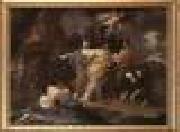 |
CRETI, Donato -- Click Here
|
|
Italian painter, Bolognese school (b. 1671, Bologna, d. 1749, Bologna)
Italian painter and draughtsman. His individual and poetic art represents, with that of Marcantonio Franceschini, the last significant expression of the classical-idealist strain in Bolognese painting. His activity was almost wholly confined to Bologna, where he painted decorative frescoes, altarpieces and easel pictures for private collectors. Two qualities are paramount: a perfected finesse of handling and poetic suggestiveness of situation and mood. He sought the ideal beauty of the individual figure and was thus at his best in meditative pictures with few figures; his subjects combine grace of form and precision of contour with flesh that attains the surface delicacy of porcelain and colours that have a mineral-like refulgence. |
|
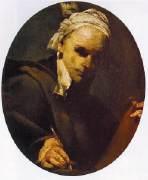 |
CRESPI, Giuseppe Maria -- Click Here
|
|
Italian Baroque Era Painter, 1665-1747
Painter, draughtsman and printmaker. His religious and mythological works are distinguished by a free brushstroke and a painterly manner. He also painted spirited genre scenes, which by their quality, content and quantity distinguish him as one of the first Italian painters of high standing to devote serious attention to the depiction of contemporary life. Such paintings as Woman Laundering (1700-05; St Petersburg, Hermitage) or Woman Washing Dishes (1720-25; Florence, Uffizi) offer straightforward glimpses of domestic chores in images that are startlingly novel for the period and look forward to the art of Jean-Simeon Chardin, Jean-Francois Millet and Honore Daumier. |
|
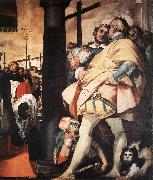 |
CRESPI, Giovanni Battista -- Click Here
|
|
Italian Baroque Era/Mannerist Painter, ca.1575-1633
|
|
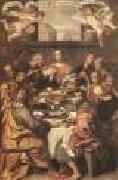 |
CRESPI, Daniele -- Click Here
|
|
Italian Baroque Era Painter, ca.1598-1630
Italian painter and draughtsman. He was the most original artist working in Milan in the 1620s, the first to break with the wilfully exaggerated manner of Lombard Mannerism and to develop an early Baroque style, distinguished by clarity of form and content. In this context his Supper of St Carlo Borromeo is one of the most famous early 17th-century pictures in northern Italy. |
|
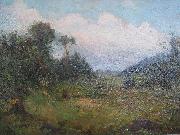 |
Creator:Edmond Dyonnet -- Click Here
|
|
He was born on 25 June 1859 in Crest (Drôme), France, from the marriage of Ulysses-Alexandre Dyonnet, industrialist, and Goullioud Albine. The real family name is Guyonnet de Pivat but due to an error of births during the French Revolution, the surname became Dyonnet. Edmond died in Montreal on 7 July 1954, at age 95. He was buried with his family in the cemetery of Notre-Dame-des-Neiges, in Montreal.
Edmond had two younger sisters, Emma Dyonnet, wife Lorin (1866-1947) and Clemence Dyonnet, wife Chabot (18? -1905). Ulysses, the father of Edmond, had an older brother Leon Dyonnet Goullioud who married Helen, the sister of Albine. Leon Dyonnet made a fortune in corsets for women in association with Amyot from 1886 to 1891 and set up the Dominion Corset company, rue de la Couronne in Quebec City. The couple had a daughter artist, cousin of Edmond Dyonnet: Eugenie Dyonnet, who immigrated to Canada in 1872 and died in 1875 in Montreal.
Edmond Dyonnet was born in Drôme in 1859, and at 9 years old, he followed his father and migrated to Italy, he continued his primary education in Turin, from 1868 to 1873, in municipal schools and then returned to France with his family in the Drôme. He studies at Crest high school from 1873 to 1875. His father Ulysses met in Paris the brother of Judge George Baby who convinced him to emigrate to Quebec.
|
|
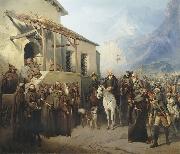 |
Creator:Adolf Charlemagne. -- Click Here
|
|
painted Field Marshal Alexander Suvorov at the top of the St. Gotthard September 13 in 1855 |
|
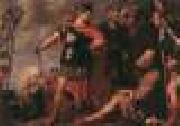 |
CRAYER, Gaspard de -- Click Here
|
|
Flemish painter (b. 1584, Antwerpen, d. 1669, Ghent) |
|
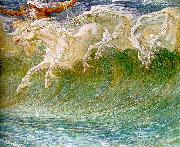 |
Crane, Walter -- Click Here
|
|
English Golden Age Illustrator, 1845-1915
English painter, illustrator, designer, writer and teacher. He showed artistic inclinations as a boy and was encouraged to draw by his father, the portrait painter and miniaturist Thomas Crane (1808-59). A series of illustrations to Tennyson's The Lady of Shalott (Cambridge, MA, Harvard U., Houghton Lib.) was shown first to Ruskin, who praised the use of colour, and then to the engraver William James Linton, to whom Crane was apprenticed in 1859. From 1859 to 1862 Crane learnt a technique of exact and economical draughtsmanship on woodblocks. |
|
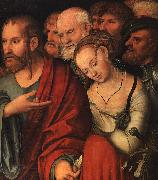 |
CRANACH, Lucas the Younger -- Click Here
|
|
German painter (b. 1515, Wittenberg, d.1586, Weimar)
was a German Renaissance artist, known for his woodcuts and paintings. He was a son of Lucas Cranach the Elder who began his career as an apprentice in his father's workshop. Henceforth, his own reputation and fame grew. After his father's death, he assumed control over the workshop. The style of their paintings can be so similar that there have been some difficulties in attribution of their works. |
|
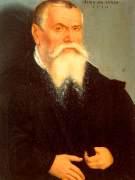 |
CRANACH, Lucas the Elder -- Click Here
|
|
German painter (b. 1472, Kronach, d. 1553, Weimar).
German painter and engraver. The son of a painter, he settled in Wittenberg c.1504 and was court painter successively under three electors of Saxony. There he maintained a flourishing workshop and was twice burgomaster. Cranach was a close friend of Martin Luther, whose doctrine he upheld in numerous paintings and woodcuts, and he has been called the painter of the Reformation. He was a rapid and prolific painter, and the work turned out by his studio is uneven in quality. Naïve and fanciful, often awkward in draftsmanship, it has, nonetheless, freshness and originality and a warm, rich palette. His portraits are particularly successful. Among his best-known works are Repose in Egypt (Gemäldgalerie, Staatliche Mus., Berlin-Dahlem); Judgment of Paris (Staatliche Kunsthalle, Karlsruhe); Adam and Eve (Courtauld Inst., London); and Crucifixion (Weimar). The latter contains figures of Luther and Cranach. His many famous protraits include those of Elector John Frederick and Self-Portrait (Uffizi). Cranach was also an accomplished miniaturist. He produced a few copperplates and designs for woodcuts. His son and pupil Lucas Cranach, the Younger, 1515C86, |
|
 |
Cranach, Lucas il Vecchio -- Click Here
|
|
German
tedesco, 1472-1553 |
|
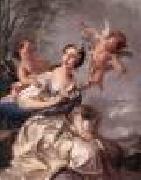 |
COYPEL, Noel Nicolas -- Click Here
|
|
French painter (b. 1690, Paris, d. 1734, Paris)
was a popular French artist. The son of Noël Coypel and half-brother to the more-famous painter Antoine Coypel, he was accredited to the Academie Royale in 1716. He was appointed a professorship in 1733
|
|
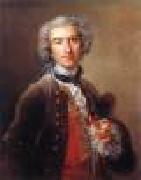 |
COYPEL, Charles-Antoine -- Click Here
|
|
French Painter, 1694-1752
|
|
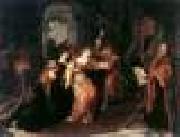 |
COYPEL, Antoine -- Click Here
|
|
French Baroque Era Painter, 1661-1722
director of the French Royal Academy and principal painter of Louis XV. He illustrated many literary works, including editions of Moliere's plays, and was himself a prolific dramatist. Coypel wrote one fairy tale, Agla ou Nabotine (Agla or Little One?), published posthumously in 1779. Coypel weaves several traditional fairy tale motifs into the story of a benevolent fairy who tests the kindness and sincerity of an ugly little girl whose virtue is eventually rewarded with beauty and the love of a handsome young man.
|
|
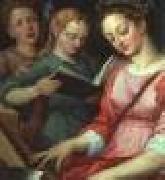 |
COXCIE, Raphael -- Click Here
|
|
Flemish painter (b. 1540, Mechelen, d. 1616, Brussels).
|
|
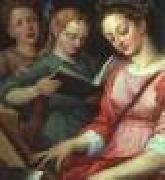 |
COXCIE, Michiel van -- Click Here
|
|
Flemish Northern Renaissance Painter, 1499-1592 |
|
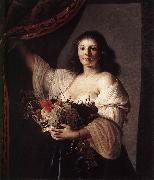 |
COUWENBERGH, Christiaen van -- Click Here
|
|
Dutch painter, Delft school (b. 1604, Delft, d.
1667, Cologne). |
|
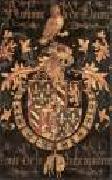 |
COUSTENS, Pieter -- Click Here
|
|
Flemish painter (active 1453-1487 in Bruges and Brussels) |
|
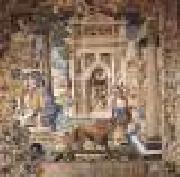 |
COUSIN, Jean the Elder -- Click Here
|
|
French High Renaissance Painter, ca.1495-1560 |
|
 |
COURTOIS, Jacques -- Click Here
|
|
French Baroque Era Painter, 1621-1676
was a French painter. He was born at Saint-Hippolyte, near Besançon. His father was a painter, and with him Jacques remained studying up to the age of fifteen. Towards 1637 he went to Italy, was received at Milan by a Burgundian gentleman, and entered, and for three years remained in the French military service. The sight of some battle-pictures revived his taste for fine art. He went to Bologna, and studied under the friendly tutelage of Guido Reni; thence he proceeded to Rome, where he painted, in the Cistercian monastery, the "Miracle of the Loaves." Here he took a house and after a while entered upon his own characteristic style of art, that of battle-painting, in which he has been accounted to excel all other old masters; his merits were cordially recognized by the celebrated Cerquozzi, named Michelangelo delle Battaglie. He soon rose from penury to ease, and married a painter's daughter, Maria Vagini; she died after seven years of wedded life. Prince Matthias of Tuscany employed Courtois on some striking works in his villa, Lappeggio, representing with much historical accuracy the princes military exploits. In Venice also the artist executed for the senator Sagredo some remarkable battle-pieces. In Florence he entered the Society of Jesus, taking the habit in Rome in 1655; it was calumniously rumoured that he adopted this course in order to escape punishment for having poisoned his wife. As a Jesuit Brother, Courtois painted many works in churches and monasteries of the society. He lived piously in Rome, and died there of apoplexy on 20 May 1676 (some accounts say 1670 or 1671). His battle-pieces have movement and fire, warm colouring (now too often blackened), and great command of the brush, those of moderate dimensions are the more esteemed. They are slight in execution, and tell out best from a distance. |
|
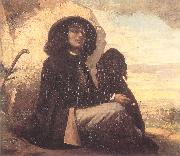 |
Courbet, Gustave -- Click Here
|
|
French Realist Painter, 1819-1877
Gustave Courbet was born at Ornans on June 10, 1819. He appears to have inherited his vigorous temperament from his father, a landowner and prominent personality in the Franche-Comt region. At the age of 18 Gustave went to the College Royal at Besançon. There he openly expressed his dissatisfaction with the traditional classical subjects he was obliged to study, going so far as to lead a revolt among the students. In 1838 he was enrolled as an externe and could simultaneously attend the classes of Charles Flajoulot, director of the cole des Beaux-Arts. At the college in Besançon, Courbet became fast friends with Max Buchon, whose Essais Poetiques (1839) he illustrated with four lithographs. In 1840 Courbet went to Paris to study law, but he decided to become a painter and spent much time copying in the Louvre. In 1844 his Self-Portrait with Black Dog was exhibited at the Salon. The following year he submitted five pictures; only one, Le Guitarrero, was accepted. After a complete rejection in 1847, the Liberal Jury of 1848 accepted all 10 of his entries, and the critic Champfleury, who was to become Courbet's first staunch apologist, highly praised the Walpurgis Night. Courbet achieved artistic maturity with After Dinner at Ornans, which was shown at the Salon of 1849. By 1850 the last traces of sentimentality disappeared from his work as he strove to achieve an honest imagery of the lives of simple people, but the monumentality of the concept in conjunction with the rustic subject matter proved to be widely unacceptable. At this time the notion of Courbet's "vulgarity" became current as the press began to lampoon his pictures and criticize his penchant for the ugly. His nine entries in the Salon of 1850 included the Portrait of Berlioz, the Man with the Pipe, the Return from the Fair, the Stone Breakers, and, largest of all, the Burial at Ornans, which contains over 40 life-size figures whose rugged features and static poses are reinforced by the somber landscape. A decade later Courbet wrote: "The basis of realism is the negation of the ideal. Burial at Ornans was in reality the burial of romanticism." In 1851 the Second Empire was officially proclaimed, and during the next 20 years Courbet remained an uncompromising opponent of Emperor Napoleon III. At the Salon of 1853, where the painter exhibited three works, the Emperor pronounced one of them, The Bathers, obscene; nevertheless, it was purchased by a Montpellier innkeeper, Alfred Bruyas, who became the artist's patron and host. While visiting Bruyas in 1854 Courbet painted his first seascapes. Among them is the Seashore at Palavas, in which the artist is seen waving his hat at the great expanse of water. In a letter to Jules Vall's written in this period Courbet remarked: "Oh sea! Your voice is tremendous, but it will never succeed in drowning out the voice of Fame shouting my name to the entire world." Courbet was handsome and flamboyant, naively boastful, and aware of his own worth. His extraordinary selfconfidence is also evident in another painting of 1854, The Meeting, in which Courbet, stick in hand, approaches Bruyas and his servant, who welcome him with reverential attitudes. It has recently been shown that the picture bears a relationship to the theme of the Wandering Jew as it was commonly represented in the naive imagery of the popular Épinal prints. Of the 14 paintings Courbet submitted to the Paris World Exhibition of 1855, 3 major ones were rejected. In retaliation, he showed 40 of his pictures at a private pavilion he erected opposite the official one. In the preface to his catalog Courbet expressed his intention "to be able to represent the customs, the ideas, the appearance of my own era according to my own valuation; to be not only a painter but a man as well; in short, to create living art." One of the rejected works was the enormous painting The Studio, the full title of which was Real Allegory, Representing a Phase of Seven Years of My Life as a Painter. The work is charged with a symbolism which, in spite of obvious elements, remains obscure. At the center, between the two worlds expressed by the inhabitants of the left and right sides of the picture, is Courbet painting a landscape while a nude looks over his shoulder and a child admires his work. Champfleury found the notion of a "real allegory" ridiculous and concluded that Courbet had lost the conviction and simplicity of the earlier works. Young Ladies by the Seine (1856) only served to further convince the critic of Courbet's diminished powers. But if Courbet had begun to disappoint the members of the old realist circle, his popular reputation, particularly outside France, was growing. He visited Frankfurt in 1858-1859, where he took part in elaborate hunting parties and painted a number of scenes based on direct observation. His Stag Drinking was exhibited in Besançon, where Courbet won a medal, and in 1861 his work, as well as a lecture on his artistic principles, met with great success in Antwerp. With the support of the critic Jules Castagnary, Courbet opened a school where students dissatisfied with the training at the cole des Beaux-Arts could hear him extol the virtues of independence from authority and dedication to nature. |
|
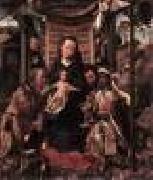 |
COTER, Colijn de -- Click Here
|
|
Flemish painter (b. ca. 1446, Bruxelles, 1538, Bruxelles) |
|
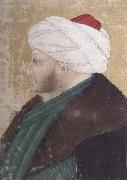 |
Costanzo da Ferrara -- Click Here
|
|
the period of 1465-1535
|
|
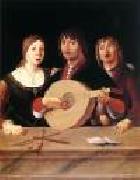 |
COSTA, Lorenzo -- Click Here
|
|
Italian High Renaissance Painter, ca.1460-1535
was an Italian painter of the Renaissance. He was born at Ferrara, but moved to Bologna by the his early twenties, and would be more influential to the Bolognese school of painting. However, many artists worked in both nearby cities, and thus others consider him a product of the School of Ferrara. There are claims that he trained with Cosimo Tura. In 1483 he painted his famous Madonna and Child with the Bentivoglio family, and other frescoes, on the walls of the Bentivoglio chapel in San Giacomo Maggiore, and he followed this with many other works. He was a great friend of Francesco Francia, who was much influenced by him. In 1509 he went to Mantua, where his patron was the Marquis Francesco Gonzaga, and he eventually died there. His Madonna and Child enthroned is in the National Gallery, London, but his chief works are at Bologna. His sons, Ippolito and Girolamo, were also painters, and so was Girolamo's son, Lorenzo the younger (1537-1583). |
|
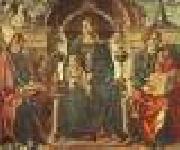 |
COSSA, Francesco del -- Click Here
|
|
Italian Early Renaissance Painter, ca.1435-1477
Italian painter. Together with Cosimo Tura and Ercole de' Roberti, Cossa was one of the most important painters working in Ferrara and Bologna in the second half of the 15th century. With them he shared an expressive use of line and solidity of form, but he also had a gift for decorative and anecdotal scenes, most evident in the frescoes in the Palazzo Schifanoia, Ferrara. |
|
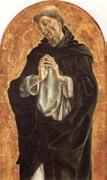 |
Cosme Tura -- Click Here
|
|
Italian Early Renaissance Painter, ca.1430-1495
Italian Renaissance artist. He was a leading master of the school of Ferrara and court painter to the city's ruling Este family. Often vividly emotional, Tura's figures range from the graceful to the grotesque, as in the gentle Mary and contorted Jesus of his c.1472 Pieta (Correr Museum, Venice). Combining material splendor with asceticism, his stylistically idiosyncratic paintings are frequently filled with sharply portrayed natural details??diversified landscapes, squirrels, monkeys, fruits, etc.??that serve as both plastic and iconographic elements. His works are executed in a harsh, nervously linear, and rather angular style, with bold and sometimes strident coloring. Examples of his art include two organ panels, Annunciation and St. George Slaying the Dragon (cathedral, Ferrara); Christ on the Cross (Milan); St. Jerome (National Gall., London); Portrait of a Man and Saints (National Gall. of Art, Washington, D.C.). Attributed to him is a portrait of a member of the Este family, The Flight into Egypt, and St. Louis of Toulouse |
|
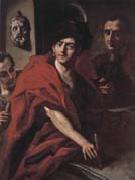 |
Cosmas Damian asam -- Click Here
|
|
1686-1739
Tegernsee, Bavaria died April 29, 1750, Mannheim, Palatinate) Bavarian architects and decorators. After studying in Rome (1711 C 13), Cosmas Damian became a prolific fresco painter, and his brother, Egid Quirin, became a sculptor and stuccoist. They developed the effects of dramatic lighting and illusionism originated by Gian Lorenzo Bernini and Andrea Pozzo. Working as a team, they produced magnificent illusionistic decoration in ecclesiastical buildings, combining dramatic lighting and colour. Their works are notable for their profound and dramatic intensity of religious feeling. The brothers became the principal late Baroque exponents of illusionist decoration in religious architecture. Their most notable collaboration is the church of St. John Nepomuk in Munich |
|
 |
Cosimo Tura -- Click Here
|
|
1430-95
Italian Cosimo Tura Galleries
Cosimo Tura (c. 1430 ?C 1495), also known as Il Cosm?? or Cosme Tura, was an Italian early-Renaissance (or Quattrocento) painter and considered one of the founders of the School of Ferrara.
Born in Ferrara, he was a student of Francesco Squarcione of Padua. Later he obtained patronage from both Dukes Borso and Ercole I d'Este. By 1460, he was stipended by the Ferrarese Court. His pupils include Francesco del Cossa and Francesco Bianchi. He appears influenced by Mantegna's and Piero della Francesca's quattrocento styles.
In Ferrara, he is well represented by frescoes in the Palazzo Schifanoia (1469?C71) . This pleasure palace, with facade and architecture of little note, belonged to the d'Este family and is located just outside the medieval town walls. Cosimo, along with Francesco del Cossa, helped produce an intricately conceived allegorical series about the months of the year and zodiac symbols. The series contains contemporary portraits of musicians, laborers, and carnival floats in idyllic parades. As in Piero della Francesca's world, the unemotive figures mill in classical serenity.
He also painted the organ doors for the Duomo showing the Annunciation (1469). He collaborated in the painting of a series of "muses" for a studiolo of Leonello d'Este, including the allegorical figure of Calliope at the National Gallery (see image). While the individual attributions are often debated, among the artists thought to complete the Angelo di Pietro da Sienna, also called Maccagino or Angelo Parrasio, and Michele Pannonio. |
|
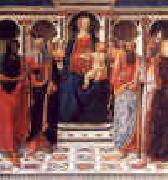 |
Cosimo Rosselli -- Click Here
|
|
Italian
1439-1507
Cosimo Rosselli Gallery
Born in Florence, at the age of fourteen he became a pupil of Neri di Bicci, and in 1460 he worked as assistant to his cousin Bernardo di Stefano Rosselli. A first youthful work of Cosimo mentioned by Giorgio Vasari is the Assumption of the Virgin altarpiece in the third chapel on the left of the nave in Sant'Ambrogio in Florence. In the same church, on the wall of one of the chapels, is a fresco by Cosimo which Vasari praises highly, especially for a portrait of the young scholar Pico of Mirandola. The scene, a procession bearing a miracle-working chalice, is painted with vigor and less mannerism than most of this artist's work. A picture painted by Rosselli for the church of the Annunziata, with figures of SS. Barbara, Matthew and the Baptist, is in the Academy of Florence.
Rosselli also spent some time in Lucca, where he painted several altar-pieces for various churches. A picture attributed to him, taken from the church of St. Girolamo at Fiesole, is now in the National Gallery of London. It is a large retable, with, in the center, St. Jerome in the wilderness kneeling before a crucifix, and at the sides standing figures of St. Damasus and St. Eusebius, St. Paula and St. Eustochium; below is a predella with small subjects. Though dry and hard in treatment, the figures are designed with much dignity.
The Berlin Gallery possesses three pictures by Rosselli: The Virgin in Glory, The Entombment of Christ, and The Massacre of the Innocents. In 1480 Rosselli, together with the chief painters of Florence, was invited by Pope Sixtus IV to Rome to assist in the painting of the frescoes in the Sistine Chapel. Three of these were executed by him The Destruction of Pharaohs Army in the Red Sea, Christ Preaching by the Lake of Tiberias, and The Last Supper. Rosselli's Sistine frescoes were partly painted by his assistant and son in law Piero di Cosimo, who was so called after Cosimo Rosselli. His chief pupil was Fra Bartolomeo.
According to Vasari, Rosselli died in 1484, but this is a mistake, as his is known to be living on 25 November 1506 |
|
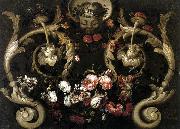 |
CORTE, Gabriel de la. -- Click Here
|
|
Spanish painter
b. 1648, Madrid, d. 1694, Madrid |
|
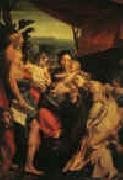 |
Correggio -- Click Here
|
|
Italian 1489-1534
Correggio Locations
Italian painter and draughtsman. Apart from his Venetian contemporaries, he was the most important northern Italian painter of the first half of the 16th century. His best-known works are the illusionistic frescoes in the domes of S Giovanni Evangelista and the cathedral in Parma, where he worked from 1520 to 1530. The combination of technical virtuosity and dramatic excitement in these works ensured their importance for later generations of artists. His altarpieces of the same period are equally original and ally intimacy of feeling with an ecstatic quality that seems to anticipate the Baroque. In his paintings of mythological subjects, especially those executed after his return to Correggio around 1530, he created images whose sensuality and abandon have been seen as foreshadowing the Rococo. Vasari wrote that Correggio was timid and virtuous, that family responsibilities made him miserly and that he died from a fever after walking in the sun. He left no letters and, apart from Vasari account, nothing is known of his character or personality beyond what can be deduced from his works. The story that he owned a manuscript of Bonaventura Berlinghieri Geographia, as well as his use of a latinized form of Allegri (Laetus), and his naming of his son after the humanist Pomponius Laetus, all suggest that he was an educated man by the standards of painters in this period. The intelligence of his paintings supports this claim. Relatively unknown in his lifetime, Correggio was to have an enormous posthumous reputation. He was revered by Federico Barocci and the Carracci, and throughout the 17th and 18th centuries his reputation rivalled that of Raphael. |
|
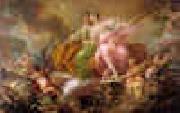 |
Corrado Giaquinto -- Click Here
|
|
1703-1766
Italian
Corrado Giaquinto Galleries
He was born in Molfetta. As a boy he apprenticed with a modest local painter Saverio Porta, (c1667-1725), escaping the religious career his parents had intended for him. By October 1724, he left Molfetta, and along with his contemporaries Francesco de Mura (1696-1784) and Giuseppe Bonito (1707-1789), he trained from 1719-23 in the prolific Neapolitan studio of Francesco Solimena, either with Solimena or his pupil, Nicola Maria Rossi. Throughout his life, Giaquinto was a peripatetic painter, with long sojourns in Naples, Rome (between 1723-53), Turin (1733 and 1735-9), and Madrid (1753-1761).
In 1723, he moved to Rome to work in the studio of Sebastiano Conca. He painted in San Lorenzo in Damaso, San Giovanni Calibita, and the ceiling at Santa Croce in Gerusalemme. In March 1727, with Giuseppe Rossi as an assistant, Giaquinto opened an independent studio near the Ponte Sisto, in the parish of Saint Giovanni of the Malva in Rome. In 1734, he married Caterina Silvestri Agate.
The first documented work by his hand is Christ crucified with the Madonna, Saint John Evangelist, and Magdalene commissioned in 1730 by king John V of Portugal for the cathedral of the Mafra. In 1731, he received a prestigious commission, to execute frescoes in the church of San Nicola dei Lorenesi: Saint Nicholas water gush from cliff, three theologic and cardinal Virtues, and in the cupola Paradise. The latest restoration confirms Giaquinto stylistic independence from Solimena, and reveals his stylistic dependence on Luca Giordano. |
|
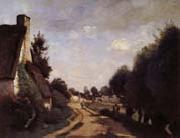 |
Corot Camille -- Click Here
|
|
French Realist Painter ,
1796-1875
French painter, draughtsman and printmaker. After a classical education at the Coll?ge de Rouen, where he did not distinguish himself, and an unsuccessful apprenticeship with two drapers, Corot was allowed to devote himself to painting at the age of 26. He was given some money that had been intended for his sister, who had died in 1821, and this, together with what we must assume was his family's continued generosity, freed him from financial worries and from having to sell his paintings to earn a living. Corot chose to follow a modified academic course of training. He did not enrol in the Ecole des Beaux-Arts but studied instead with Achille Etna Michallon and, after Michallon's death in 1822, with Jean-Victor Bertin. Both had been pupils of Pierre-Henri Valenciennes, and, although in later years Corot denied that he had learnt anything of value from his teachers |
|
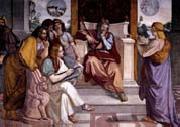 |
CORNELIUS, Peter -- Click Here
|
|
1824-1874,German composer. Trained as actor and violinist, and friend of artists, poets and writers, he devoted himself to music from the 1840s, finding inspiration in Liszt and the New German School at Weimar in 1852. His first mature works were the lieder opp. 1 and 2 and the song cycle Trauer und Trost op.3, followed by the comic opera Der Barbier von Bagdad (1855-8); all show his literary skill, refreshing simplicity and musical independence from the Liszt circle. In Vienna (1859-65), he wrote his second opera Der Cid and enjoyed fruitful relationships with Brahms, Carl Tausig and above all Wagner, who summoned him to Munich in 1865 as his private repetiteur and teacher at the Royal School of Music. His third opera Gunlöd was never finished. He continued to write poetry and essays defending Wagner and Liszt and translated vocal works by Pergolesi, Berlioz, Liszt and others. Although he revered Wagner, he stood ethically and artistically apart, his work (especially Der Barbier) thus representing an original achievement. |
|
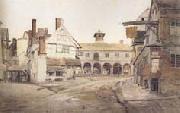 |
Cornelius Varley -- Click Here
|
|
English Painter, 1781-1873
Painter, draughtsman and printmaker, brother of (1) John Varley. Primarily a scientist, he painted watercolours for pleasure. He was less prolific than his brother. Although he was also a founder-member of the Society of Painters in Water-Colours, he exhibited few watercolours there from 1805 to 1820 and even fewer at the Royal Academy and the Society of British Artists between 1820 and 1859 and 1826 and 1844 |
|
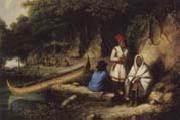 |
Cornelius Krieghoff -- Click Here
|
|
Dutch-born Canadian Painter, 1815-1872
Canadian painter of Dutch birth. He learnt the rudiments of music and painting from his father and about 1830 attended the Akademie der Bildenden Kenste in D?sseldorf. He moved to America c. 1835 and enlisted in the US army. In New York he met Louise Gauthier, a French-Canadian, and settled in Montreal with her in 1840, working as a painter and a musician. In 1842-3 he had a studio in Rochester, NY; in the following year he studied in Paris, making copies in the Louvre. Returning to Canada in 1845, he painted portraits in Toronto, and from 1845 to 1853 he lived in Longueuil and then in Montreal, where he produced genre paintings, landscapes and portraits. He exhibited in Montreal and Toronto, and a series of lithographs were published after his drawings. However, he found it difficult to sell his work in Montreal and had to resort more or less completely to sign-painting for a living. About 1853, at the instigation of the auctioneer John Budden, Krieghoff settled in Quebec City. He lived there for 11 years, making several trips to Europe. During this period of intensive production, he achieved popularity and prosperity and painted his best-known pictures, which were scenes depicting the local townspeople and the North American Indians, and views of Quebec City and the surrounding region. About 1858 he made panoramic paintings of Canada for the Provincial Parliament buildings in Quebec. From 1864 to 1867 he lived in Paris and Munich, |
|
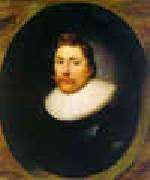 |
Cornelius Johnson -- Click Here
|
|
1593-1661
British
Cornelius Johnson Gallery |
|
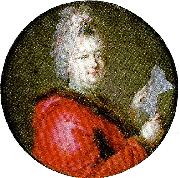 |
cornelius hoyer -- Click Here
|
|
Cornelius Höyer, född 1741, död 1804, var en dansk målare.
Höyer studerade dels i Köpenhamn, dels i Paris och Italien samt var redan 1769, då han återkom hem, en ansedd konstnär inom sitt fack, miniatyrmåleriet. 1770 blev han hovminiatyrmålare och medlem av konstakademien. Från 1777 var han dennas sekreterare.
|
|
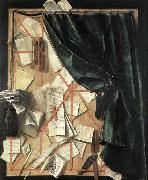 |
Cornelius Gijsbrechts -- Click Here
|
|
Flemish Baroque Era Painter, ca.1630-1675 |
|
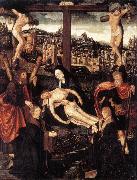 |
CORNELISZ VAN OOSTSANEN, Jacob -- Click Here
|
|
Dutch Northern Renaissance Painter, ca.1472-1533
North Netherlandish painter, designer and woodcutter. He was the brother of Cornelis Buys I ( fl 1490-1524), who is usually identified as the MASTER OF ALKMAAR (see MASTERS, ANONYMOUS, AND MONOGRAMMISTS, |
|
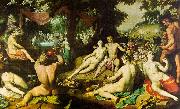 |
Cornelisz van Haarlem -- Click Here
|
|
1562-1638
Dutch
Cornelisz van Haarlem Galleries
Dutch painter and draughtsman. He came from a wealthy family. During the Spanish siege and occupation of Haarlem (1572-7), his parents moved elsewhere, leaving their son and large house in the protection of the painter Pieter Pietersz. (1540/41-1603), who became Cornelis's teacher. In 1579 Cornelis travelled to France by sea, but the journey terminated at Rouen because of an outbreak of plague. He then became a pupil of Gillis Congnet in Antwerp, with whom he stayed for one year. In 1580-81 he returned permanently to Haarlem, and in 1583 he received his first official commission from the city, a militia company portrait, the Banquet of the Haarlem Civic Guard (Haarlem, Frans Halsmus.). Around 1584 he befriended Hendrick Goltzius and Karel van Mander, with whom he is said to have established a kind of academy. |
|
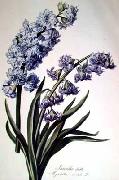 |
Cornelis van Spaendonck Prints -- Click Here
|
|
Dutch 1756-1840
Cornelis van Spaendonck (7 December 1756 - 22 December 1839) was a Dutch painter who was a native of Tilburg. Spaendonck initially worked under artist Guillaume-Jacques Herreyns (1743-1827) in Antwerp, and in 1773 moved to Paris to study and work with his brother, floral painter G??rard van Spaendonck (1746-1822). From 1785 to 1800, Cornelis van Spaendonck was head of the porcelain works at S??vres. Due to difficulties encountered as an administrator, he was relieved of his directorship in 1800, but remained at S??vres as a designer and artist until 1808.
In 1789 Spaendonck became a member of the Acad??mie des Beaux Arts. He painted throughout his lifetime, and displayed his works at the Salons of Paris until 1833. Most of Spaendonck's works were created with oils and gouache, and he is remembered for his lush still-lifes of flowers. Among his paintings were subjects such as De Fleurs Et Fruits, Vase De Fleurs, Bouquet De Different Fleurs, Fleurs Du Jardin, Corbeille Fleurs, et al. At his death in 1840 there were 29 paintings in his studio, which were auctioned soon afterwards. |
|
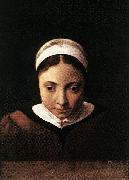 |
Cornelis van Poelenburch -- Click Here
|
|
(1594 - 12 August 1667) was a Dutch Golden Age landscape painter.
Though his birthplace is unknown, a signed document survives in Utrecht where he is listed as six years old and the son of Simon van Poelenburch, a Catholic canon in Utrecht.He initially trained with Abraham Bloemaert, and his earliest signed paintings are from 1620.He traveled to Rome where he was influenced by Adam Elsheimer and became a founding member of the Bentvueghels. He counted a few cardinals under his patrons, and was called to England by Charles I of England, for whom he made small cabinet pieces. He returned to Utrecht where he later died just a few years after his old teacher Abraham Bloemaert.He painted mostly small landcapes with mythical or religious figures or passages, in a style that would later be evident in some of the works of Claude Lorraine.
His "most important and successful" pupils were Daniël Vertangen, Dirck van der Lisse, François Verwilt, and Jan van Haensbergen. Arnold Houbraken claimed that his best pupil was Joan vander Lis from Breda (not Dirk vander Lis from The Hague). Houbraken then mentioned Vertangen, Verwilt, Warnard van Rysen from Bommel, and Willem van Steenree, a nephew. The RKD also mentions Laurens Barata. |
|
|